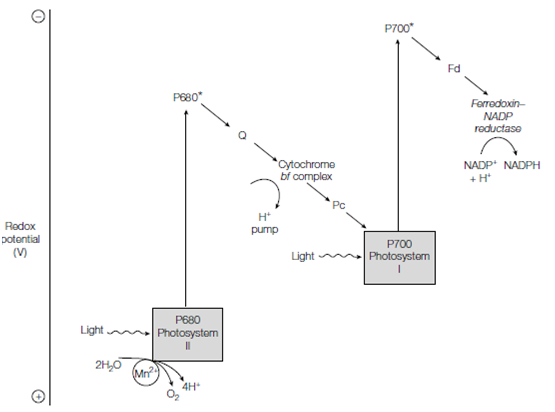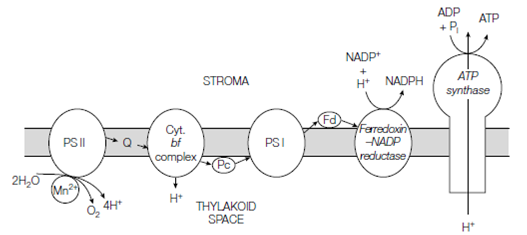Light reactions in eukaryotic photosynthesis
Photosynthesis occurs within antenna complexes and reaction centers in the thylakoid membrane of chloroplasts in eukaryotic microorganisms. The Antenna complexes are formed from various hundred chlorophyll molecules plus accessory pigments. Light excitation of the chlorophyll molecule results in an electron in a chlorophyll molecule being excited to a higher orbit and this energy is transferred among chlorophylls until it is channeled into the chlorophyll molecules of the reaction center.
The reaction center contains two photosystems called photosystem I and photo- system II with different light-energy absorption maxima. PS I absorbs at 700 nm and PS II at 680 nm. The reaction centers are linked through other electron carriers and if the components are arranged through their redox potentials they assume a Z shape so the scheme is called the Z scheme .
The reactions of the Z scheme generate NADPH from NADP. ATP is generated by noncyclic phosphorylation reactions because of the creation of a proton gradient among the thylakoid space and the stroma through the reactions of PS I and PS II. H+ is pumped from the stroma into the thylakoid space. ATP is generated as protons return to the stroma via an ATP synthase present in the thylakoid membrane in Figure . PS I may operate without PS II in some circumstances and in this reaction no O2 is produced only ATP is produced via the proton gradient.

Figure . The Z scheme for noncyclic photophosphorylation.

Figure . Formation of the proton gradient and ATP synthesis. From Hames D & Hooper N (2011) Instant Notes Biochemistry, 4th ed. Garland Science.